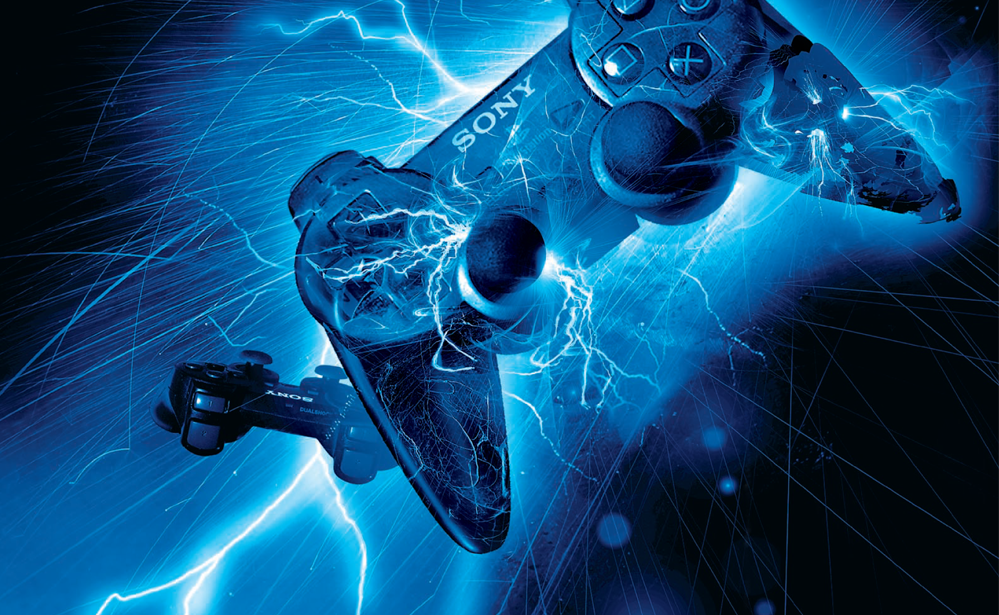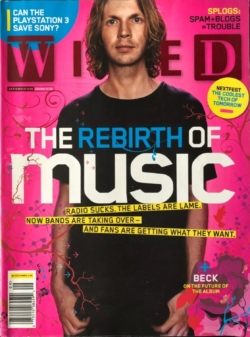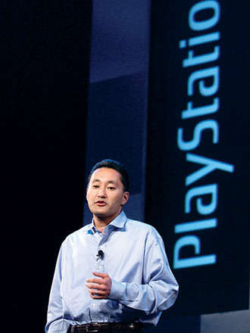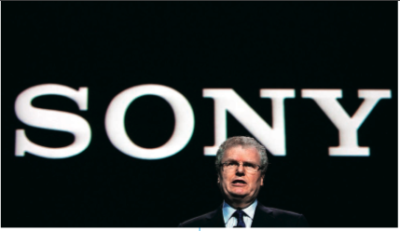Gamers in the mid-’00s were excited about Sony’s forthcoming PlayStation 3 — until they heard the price. That’s when it became apparent its real function wasn’t to keep them entertained but to beat Microsoft in a “war for the living room.”

Illustration by John Blackford
NEVER TRY TO INTRODUCE THE SAME PRODUCT TWICE. That was the lesson from the Electronic Entertainment Expo in May. A year earlier, at E3 2005 in Los Angeles, Sony had wowed the videogame industry with demonstrations of the upcoming PlayStation 3’s unprecedented graphical muscle. The machine wouldn’t be available until months after Microsoft’s next-gen console, the Xbox 360. Yet based on the spectacular preview, many gamers had no problem waiting for the PS3. Then, early this year, Sony dropped a bombshell: The PS3 release would be pushed back until November. So when E3 came around again this spring, everyone trooped out to the retro Hollywood lotusland of the Sony Pictures lot – only to view the same console they’d been promised the year before. Not great.
 Delays are nothing new in tech, but Sony seemed intent on making the worst of it. The crowd was kept waiting nearly an hour. Then Kaz Hirai, who heads PlayStation in North America, took the stage to declare, “The next generation doesn’t start until we say it does!” He meant it as a dig at Microsoft, but to gamers who’d been salivating for a year, his words were like a bitch slap. The demos that followed were no more impressive than those the year before. Finally, PlayStation chief Ken Kutaragi came forward to make the one announcement everyone wanted to hear: the price. $600 for the high-end model? The room gasped, then fell silent. Almost immediately, the blogosphere lit up with denunciations: Sony has turned its back on gamers. The PS3 will be a failure. Kutaragi and Hirai are idiots.
Delays are nothing new in tech, but Sony seemed intent on making the worst of it. The crowd was kept waiting nearly an hour. Then Kaz Hirai, who heads PlayStation in North America, took the stage to declare, “The next generation doesn’t start until we say it does!” He meant it as a dig at Microsoft, but to gamers who’d been salivating for a year, his words were like a bitch slap. The demos that followed were no more impressive than those the year before. Finally, PlayStation chief Ken Kutaragi came forward to make the one announcement everyone wanted to hear: the price. $600 for the high-end model? The room gasped, then fell silent. Almost immediately, the blogosphere lit up with denunciations: Sony has turned its back on gamers. The PS3 will be a failure. Kutaragi and Hirai are idiots.
PR fiascoes tend to be a sign that nobody’s thinking about the customer. E3 was Sony’s second in seven months. Last October, a security researcher reported on his blog that CDs from Sony BMG – the music label half-owned by Sony – contained antipiracy software that covertly embedded itself in computer operating systems, spying on their owners and leaving the machines themselves vulnerable to identity theft and zombie takeover attempts. Sony BMG pooh-poohed the problem and released a software fix that made it even worse. Millions of CDs had to be recalled. As class actions multiplied and even the Department of Homeland Security warned music labels against undermining computer security, angry consumers declared themselves ready to boycott anything with the Sony name on it.
Sixty years after its founding in the ashes of postwar Tokyo, the company that gave us the transistor radio and the Walkman portable music player is deeply wounded. Only once in the past five years has Sony’s all-important electronics division posted a profit; during that same period, the company’s share price has fallen by nearly half. Its hit products of the ’90s – Handycams, WEGA TVs, VAIO computers – were succeeded by stillborn wonders like the AirBoard, a $1,000 videoscreen that could be carried around like a laptop, and the Net MD Walkman, a too-little-too-late attempt to challenge Apple’s iPod. Neither this latter-day Walkman nor Sony Connect, the online music store The New York Times once called “Sony Disconnect,” would have anything to do with MP3 files – only Sony’s cumbersome and proprietary Atrac3 format would do. Now, having ceded to Apple the portable-music-player market, Sony desperately needs to stay on top in videogames. It’s not just that Sony needs a win; PS3 is critical to its entire strategy.
The PS3 is much more than a game box. Kutaragi likes to say it’s actually a computer, one that’s designed to lie at the center of the networked home, serving up films, navigating the Internet, doing nearly everything a PC can do, and delivering jaw-dropping videogames besides. The new console relies on two extremely ambitious yet untested technologies. At its core is a highly sophisticated microchip that can cruise at teraflop speeds (equal to the fastest supercomputers of less than a decade ago) and that might someday revolutionize home electronics. Also built into the machine is Sony’s new Blu-ray hi-def disc player, which is proudly incompatible with a rival format from Toshiba – and which represents a bold, some would say reckless, attempt to control the multibillion-dollar market in next-generation video discs.
Only once in the past five years has Sony’s electronics division seen a profit. If the PS3 bombs, says one observer, “there is no second coming.”
All this makes for a daring strategy, but not one that plays to Sony’s strengths. Sony has always been at its best as a personal hardware company, coming up with nifty gadgets that delight consumers. In recent decades, though, it’s become oddly fixated on imposing its own standards – Betamax for VCRs, the Mini-Disc for digital music players, the Universal Media Disc for PlayStation Portable, the Memory Stick for anything you can think of – despite the world’s unwavering rejection of those standards. And Sony has never displayed an aptitude for software or had great success with networking, the key feature Microsoft has built into the Xbox. Yet Sony has to face Microsoft not just in videogames but across the entire panoply of home electronics, which Microsoft is determined to control through software. And Sony has to do this with cash reserves of $6 billion – compared to Microsoft’s $38 billion hoard – while losing hundreds of dollars in manufacturing costs alone for every PS3 sold. Eventually, Sony’s costs will come down. But in the meantime, Goldman Sachs projects, Sony will lose nearly $2 billion on the PS3 by the end of this fiscal year in March.
A Decade of Reporting on the Global Media Conglomerates |
In the 1990s and into the 2000s, a series of ego-fueled mega-mergers led to the creation of six global media conglomerates: News Corp., Sony, AOL Time Warner, Vivendi Universal, Viacom and Walt Disney. For most, it would not end well. |
Can the PS3 Save Sony?The company that created the transistor radio and the Walkman is at the precipice.
|
Barry Diller Has No Vision for the Future of the InternetThat’s why the no-nonsense honcho of Home Shopping Network and Universal is poised to rule the interactive world.
|
The Civil War Inside SonySony Music wants to entertain you. Sony Electronics wants to equip you. Too bad their interests are diametrically opposed.
|
Big Media or BustAs consolidation sweeps the content and telecom industries, FCC Chairman Michael Powell has a plan: Let’s roll.
|
Vivendi’s High Wireless ActWill a global media company with continent-wide mobile distribution prove unbeatable?
|
Reminder to Steve Case: Confiscate the Long KnivesTime Warner brings fat pipe and petabytes of content to AOL—plus a long history of infighting and backstabbing.
|
TV or Not TVRupert Murdoch aims to capture Europe’s interactive TV market with a Sun set-top strategy. But a growing Microsoft alliance has different plans.
|
Think Globally, Script LocallyAmerican pop culture was going to conquer the world — but now local content is becoming king.
|
Edgar Bronfman Actually Has a Strategy—with a TwistThe Seagram heir is challenging Disney in theme parks and spending billions to be No. 1 in music. Can this work?
|
There’s No Business Like Show BusinessA handful of powerful CEOs are battling for the hearts, minds, and eyeballs of the world’s six billion people.
|
What Ever Happened to Michael Ovitz?Striving to make his comeback, CAA’s superagent is now an unemployment statistic. Seven lessons to be learned from the fall of the image king.
|
Can Disney Tame 42nd Street?Disney is pouring millions into one of Manhattan’s most crime-ridden blocks. What does Michael Eisner know that you don’t?
|
Twilight of the Last MogulLew Wasserman has been shaking Hollywood since the ’30s. When Seagram bought MCA, was he really out of the loop, or was he king of the dealmakers to the last?Los Angeles Times Magazine | May 21, 1995 |
HOW DID IT COME TO THIS? There were missteps aplenty, but at their root is a common dynamic: What once made Sony great has worked against it in the digital age. Sony’s course was fixed in the 1946 prospectus drawn up by cofounder Masaru Ibuka, when he set forth the new company’s purposes of incorporation. Number one on his list: “To establish an ideal factory . . . where engineers with sincere motivation can exercise their technological skills to the highest level.” To succeed, engineers would need to form small development teams and compete to build the next great gadget.
Teams of hardware engineers locked in competition: “It’s the principle Sony is built on,” says Shin’ichi Okamoto, PlayStation’s former CTO, now a Tokyo entrepreneur. “Personally, I believe it’s not such a good principle nowadays. I got this impression in the ’80s, with the technological shift to semiconductors and software” – both of which require enormous development teams that collaborate with the hardware units their work is intended for. “At Sony, most engineers want to invent something new by themselves. That’s a very different goal.”
Phil Wiser, the former CTO of Sony’s US operations, reached a similar conclusion after he was tapped to salvage Sony Connect. “With digital entertainment, you have to think about hardware, software, and services that tie them all together,” says Wiser, who managed to heave Sony onto the MP3 bandwagon before leaving earlier this year for a Silicon Valley startup. “But it’s very hard to quantify the advantage of good software. If you’re in a hardware company and you analyze it from a financial perspective, you just want to do it as cheaply as you can. Software and services are an afterthought.”
The need to replace small competitive teams with large collaborative ones did occur to a few key Sony executives. Toshitada Doi, a legendary engineer, set up a computer science lab in 1988 because he saw that the future would require networked devices and large-scale software development. Years later, then-CEO Nobuyuki Idei reorganized Sony into a series of “network companies” and charged a promising lieutenant, Yuki Nozoe, with pulling together random broadband offerings into an all-encompassing networked future. But all this talk of networks was anathema to Sony’s entrenched engineering cadre. Today, Doi, Idei, and Nozoe are all gone, victims of their failure to make a difference, swept away in the boardroom coup that in spring 2005 put Howard Stringer, a longtime media exec who’d been heading Sony’s US operations, in charge of the company.
The culture of the lone-wolf hardware engineer reached its apex when Ken Kutaragi triumphed over internal opposition to create the PlayStation. In the early ’90s, Kutaragi burst forth with a seemingly reckless scheme to take on Nintendo and Sega, the ruling powers of the game world. Yet even then he viewed Microsoft as the ultimate enemy. Shuji Utsumi, a former PlayStation exec who now heads the Tokyo-based game developer Q Entertainment, recalls an exchange in which Kutaragi declared, years before the Xbox was introduced, that his competitor was Microsoft. “I thought, what is he talking about?” Utsumi says. “Is he nuts? But even before PlayStation was born, he was predicting a big war for the living room.”
PlayStation 3 is hostage to that prediction. Because technology can be decisive in war, Kutaragi loaded the PS3 with the biggest, baddest armaments yet: the Blu-ray disc drive and the Cell microchip. He and his team had barely gotten PlayStation 2 out the door when they started conceptualizing the silicon for its successor. The result, developed in partnership with IBM and Toshiba, features a central processing unit and eight coprocessors on the same chip, working in parallel. It’s optimized for high-speed networking and fast decoding of encrypted and compressed data – copy-protected video for HDTVs, for example. Game developers now have to figure out how best to unlock its powers. Sunlight on water, creatures half-hidden by fog, age lines on a human face – “for every pixel, you can do more to synthesize reality,” says Steve Pearce, CTO of Activision. “But it’s a big challenge – our engineers have to start thinking in a new way.”
As a result, the Cell has caused a lot of headaches for developers. The Xbox 360, with its three-core PowerPC processor, has already made game development far more complicated and expensive than before. Tim Sweeney, cofounder of the North Carolina-based developer Epic Games, figures it will take at least twice the effort to fully exploit the PS3’s potential as to take the Xbox 360 to the max. Until that happens, it’s unlikely there’ll be much discernable difference between games on the two platforms. “The Cell has more theoretical computing power,” says Sweeney, “but it might be years before we see that reflected in actual performance. So it’s a fundamental question whether the long-term direction in computing is with architectures like the Cell.”
Blu-ray is equally fraught. For starters, the whole business of high-definition disc drives seems designed to invite cynicism. With DVD players now in 85 percent of US homes, sales fell in 2005 for the first time – so some manufacturers may need a next-gen disc player, but it’s not clear consumers do. Especially after August 2005, when talks aimed at averting a standards war with Toshiba’s rival HD-DVD format ended in a stalemate. Andy Parsons, who heads advanced product development at Pioneer USA (a Blu-ray supporter), says compromise was impossible: “It’s kind of like saying, ‘LCD and plasma – why don’t you combine the two?’ ” True enough – but it’s also true that Blu-ray offers Sony yet another chance to establish a proprietary format. During the ’90s, a similar conflict over the original DVD ended with Sony’s surrender and Toshiba’s collection of most of the royalties on every DVD and DVD player sold. This time, Sony had the support of the big US computer makers, most of Hollywood, and nearly all the Asian consumer electronics giants – so why not call Toshiba’s bluff?
Then there was the decision to build Blu-ray into the PlayStation 3. Sony’s logic seemed ironclad: Not only would the hi-def drive’s huge storage capacity allow for far-more-realistic and complex games, the PS3 would carry Blu-ray into millions of households and drive sales of HDTVs as well. As it turned out, however, Blu-ray has done nothing good for the PS3. Blu-ray was the main reason gamers weren’t able to get the new machine last spring: The launch had to be postponed because the new format’s digital rights management system did not yet satisfy every Hollywood studio. Blu-ray was also a big factor in the PS3’s high price tag. Of course, with stand-alone Blu-ray players starting at $1,000, the PS3 is actually a bargain – if a Blu-ray player is what you really want. If not, $600 is a lot of money. “For rich, older people it’s attractive,” Utsumi observes. “But I don’t know if they are gameplayers.”

“The next huge leap in technology doesn’t come until we launch PS3,” says Kaz Hirai, head of PlayStation in North America.
KAZ HIRAI HAS HEARD IT ALL BEFORE: the jitters about a new disc format, the complaints from game developers, the charges of hubris. When you’re this far ahead – more than 200 million PlayStations sold worldwide, compared to just 30 million Xboxes – it comes with the territory. “With every generational change, there are going to be challenges for the development teams,” he says. “If everybody said it’s a piece of cake, that’s telling me it’s not a future-proof console, that it has no headroom to grow.” And that remark at E3? “I wanted to say, look – we’re the leadership company, and we take that responsibility seriously. The next huge leap in technology does not come until we launch PlayStation 3.”
Hirai has a point: PlayStation 3 is as high-tech as it comes in gameland. Thanks to the Cell, the console can transform raw computer code into imagery that looks startlingly, almost disturbingly, real – just ask the Tiger Woods simulacrum that popped up at E3. It can render virtual worlds of shimmering beauty and mesmerizing intensity, as Warhawk, the forthcoming update of Sony’s classic flying shooter, amply demonstrates. Nonetheless, Hirai’s upbeat assessment of the PS3’s prospects seems dangerously at odds with the feeling in the videogame business. One prominent industry figure, not associated with a console maker, recalls having lunch a couple of months ago with a game-company development chief who wondered aloud if Sony was going to pull a Sega – that is, go from number one console manufacturer to out of the business.
At the root of Sony’s precarious position – not just in the industry, but with gamers at large – is the company’s overweening ambition. The PS3 is all about power. Sony has said curiously little about whether this amped-up Linux über-computer will actually be fun to play. Meanwhile, Nintendo wowed everyone at this year’s E3 with the Wii, a console you can play simply by waving a wand at the screen. And Microsoft has upped the fun quotient by making it easy to play with all your buddies online.
Sony’s response to online gaming is revealing. When Microsoft launched its Xbox Live online service in 2002, console gaming went from solo affair to global meet-up. Back then, Sony was actually the leader in online gaming, with over 400,000 subscribers to EverQuest, its massively multiplayer online game. But MMOGs were played on a computer, not a game console, and there was little communication between the San Diego-based EverQuest group and the Tokyo-based PlayStation group. Xbox Live now has more than 3 million subscribers worldwide; the only place it isn’t big is Japan. Kutaragi never fully developed his PlayStation 2 online service, which still requires game publishers to run multiplayer titles on their own servers, because it wasn’t something he saw as lacking.
Yet game developers certainly saw the need for technology that would take their games online. “It’s a very important function,” says Ichiro Otobe, chief strategist of the Tokyo-based game publisher Square Enix, “and we want it coming from the platform developer – otherwise, we have to build it ourselves.” Eventually, PlayStation execs got the idea. For more than a year, San Diego and Tokyo have been working together to come up with an answer to Xbox Live. Even so, Hirai says, “the fundamental approach is different from Microsoft’s. They name it Live and it’s a big to-do. We look at it the other way: There’s the entertainment experience, what you have in the box, all those good things, and – oh, by the way – we have an online component.”
In Sony, Microsoft may have found the ideal opponent: large, slow, still fixated on hardware, still trying to find its footing in the networked world. When Microsoft decided to move into the game business, it was because a handful of execs saw an opportunity to do for gaming what Windows had done for personal computing: transform it from a hardware-defined industry to one governed by software. J Allard, the team’s leader, argued that the success of DirectX – a Microsoft software suite that made it easy to program a PC – meant the company could simplify game development, too. Allard was just as committed to online services: If Microsoft could hook up players worldwide, it could change the nature of gameplay and make Xbox the way of the future.
“This business used to be about hardware and a cartridge you popped in,” says Peter Moore, the new leader of Xbox, at his headquarters in an office park in Redmond, Washington. “But hardware is a tough business. You need it, but you also need great software and innovative services.” A Liverpool native with an office full of autographed soccer memorabilia and a sleek new Aston Martin coupe in the parking lot, Moore knows the vulnerabilities of hardware all too well: He headed Sega of America when PlayStation 2 overwhelmed its Dreamcast machine and pushed Sega out of the business. Now he spends much of his time on what Microsoft calls “Dev Luv,” an all-out effort to give game developers the software tools and engineering support they need to make Xbox the platform of choice.
Meanwhile, Xbox Live keeps gaining new features – most recently, user profiles that allow other players to check out your skill level and reputation within the community. (Too many “avoid this player” raps and you could find yourself shunned.) And because the Xbox 360 acts as a bridge to Windows Media Center PCs, the console can serve up music and video from your hard drive and play it on any device in the house. Still, Moore notes, “we’re not driving the 360 as the hub of the home. Editing and manipulating media is better done with a keyboard and mouse.”
Like the PlayStation 3, the Xbox 360 will get a hi-def disc drive, but it won’t be built in, and it won’t be Blu-ray. Last September, Microsoft and Intel announced they were throwing their weight behind Toshiba’s HD-DVD, a move that prompted several companies from the Blu-ray camp to hedge their bet by accommodating both standards. Amir Majidimehr, Microsoft’s point man on the decision, cites several reasons for siding with Toshiba, chief among them Blu-ray’s move – largely at the behest of some copyright cops at Fox – to supplement the already draconian DRM mechanism adopted by both camps with yet another layer of protection. “We worry that this program could be hacked to do bad things,” Majidimehr says, alluding to last year’s Sony BMG fiasco. Blu-ray partisans say that’s impossible – but in any case, Majidimehr argues, “if one or the other of these layers decides it doesn’t like what you’re doing, it won’t let you play the movie.” Was the competition with Sony a factor, too? “Of course,” he says. “But our strategy is, people want to play games, so we build a game console. Sony is like, all or nothing. They’re going to have a world of hurt waiting for them at the end of this year.”

Howard Stringer, appointed chair and CEO after a boardroom coup in 2005.

 September 1, 2006
September 1, 2006





